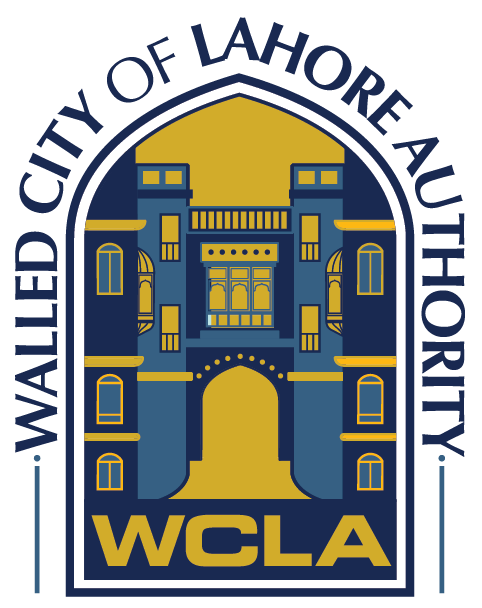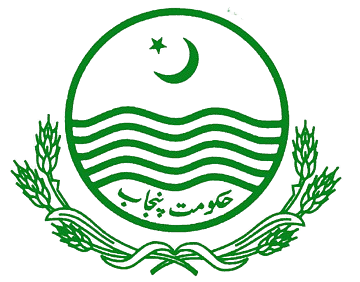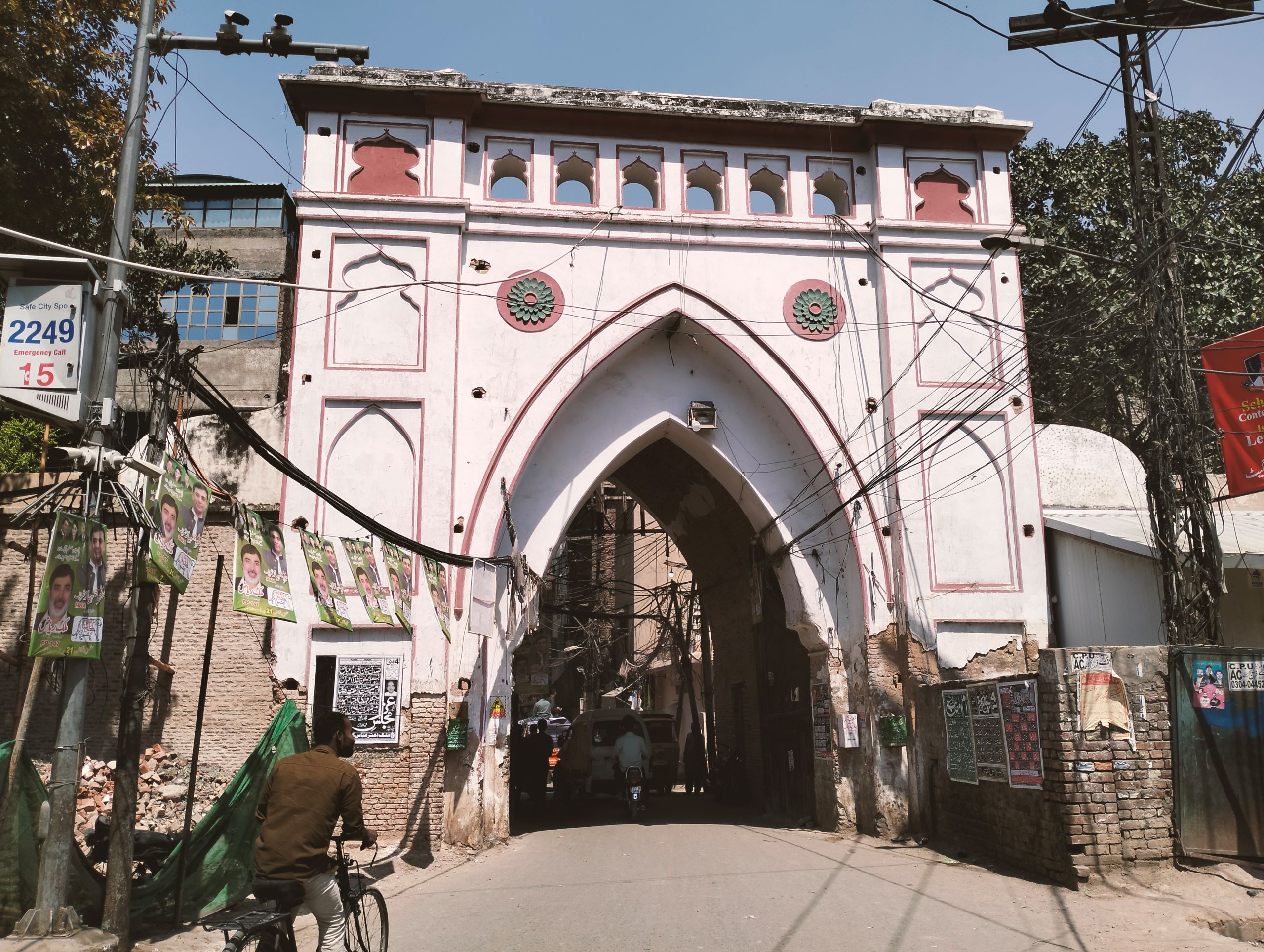

Bhatti Gate
Bhatti Gate is named after the Bhattis, on ancient Rajput tribe, which invaded the quarters in old times. The most popular market here is the Hakiman wala bazar as the name suggests there are a number of Hakim shops here. A museum named Faqir Khana Museum is also located near Bhatti gate, where there are a number of ancient remnants of different old times. Old house of famous poet and philosopher Allama Mohammad Iqbal R.A is also located in Bhatti gate. He used to live here when he was doing his graduation. An old school named Victoria girls high school is also present here; it is given the name Victoria after the name of Queen Victoria. People of Bhatti gate are lively and they love to eat heavy and good food mainly Sri pai, Halva puri and Lassi. The favorite sport among the people here is wrestling. Famous wrestler Kala Maro also belongs to Bhatti gate. Towards the anarchic end of Sikh rule in the mid-19th century both the city walls and its gates were neglected and they were finally pulled down by the British. The gate was again rebuilt in British period. The main gateway faces south towards the incoming traffic and the two barack – like flanks face north towards the inside of the walled city.
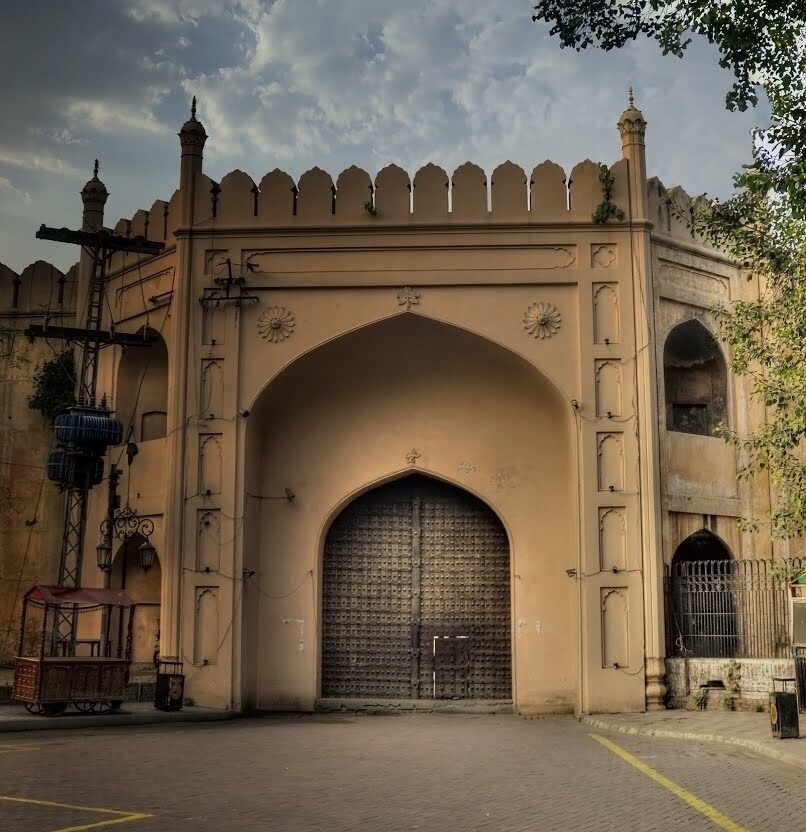
Roshnai Gate
Roshnai Gate, “The Gate of Lights” is located between the Shahi Qila (Lahore Fort) and Badshahi Mosque towards the south of the Walled City. There are two structures for Roshnai Gate, one is located alongside Ranjit Singh Samadhi and the other opens into the Fort Road Food Street. Roshnai Gate is the only existing gate still in fine condition and lives through its original looks. It served as a main entrance into the city through the fort and was specifically used by omrahs, courtiers, royal servants and entourages. In the evening, the gate was lit up and hence is named “Roshnai Darwaza”. Adjacent to the gate, Hazuri Bagh is another spot that is worth mentioning. The garden was built by Mahraja Ranjit Singh in 1813 to celebrate the seizure of the famous Koh-i-Noor Diamond from Shah Shujah of Afghanistan. There is a Baaradari known as Hazuri Bagh Baaradari and is situated in the center of the garden, but now in a very pathetic condition. The Mausoleum of Allam Muhammad Iqbal and the Samadhi of Ranjit Singh are also located in the garden.
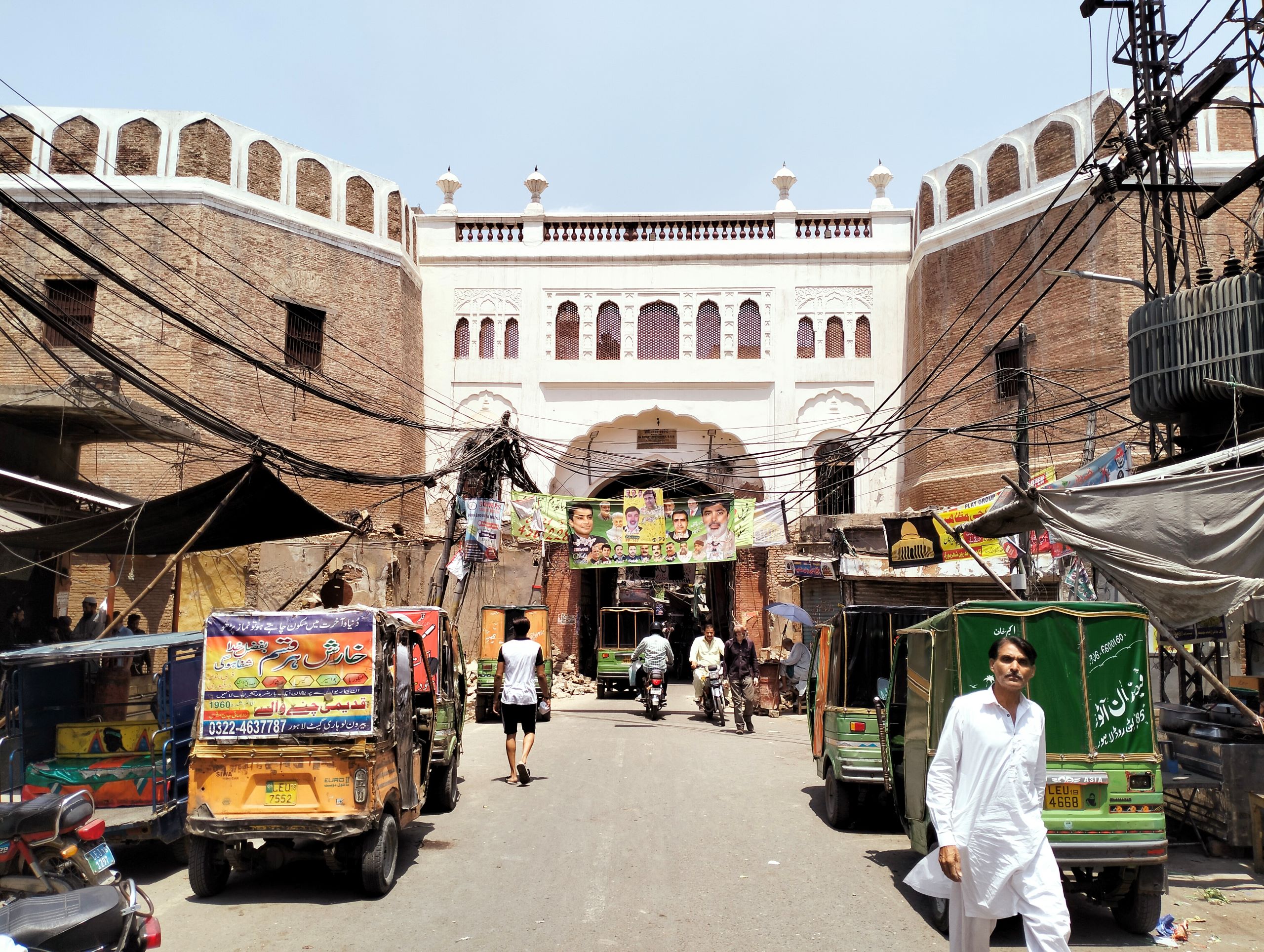
Lohari Gate
Lahori Gate, also known as the Lohari Gate, was named after the city of Lahore. It is said that when Malik Ayaz rebuilt the town in the time of Mahmud a quarter of the city initially populated the area around the gate including a market called ‘Lahori mandi’ or the Lahore market named after the city. Towards the anarchic end of Sikh rule in the mid-19th century both the city walls and its gates were neglected and finally pulled down by the British when they seized the city. They later rebuilt the gates with the Lohari Gate being reconstructed fairly close to its original design instead of gothic revival favoured by the British. A marble plaque still fixed above the arched opening record in Urdu and English that the reconstruction was carried out in 1864 under the orders of Sir Robert Monthomery K.C.B the second lieutenant governor of Punjab (1859-65) through Mr. T.D. Forsyth Commissioner and Captain Hall, Deputy Commissioner Lahore,under the Supervision of one Abdul Majeed khan. Among the five remaining gates built during the British period, Lohari Gate is the only one least affected by European styles. It has two large bastions on either side of a central gate structure with the western bastion attached to a short stub of the old city wall.
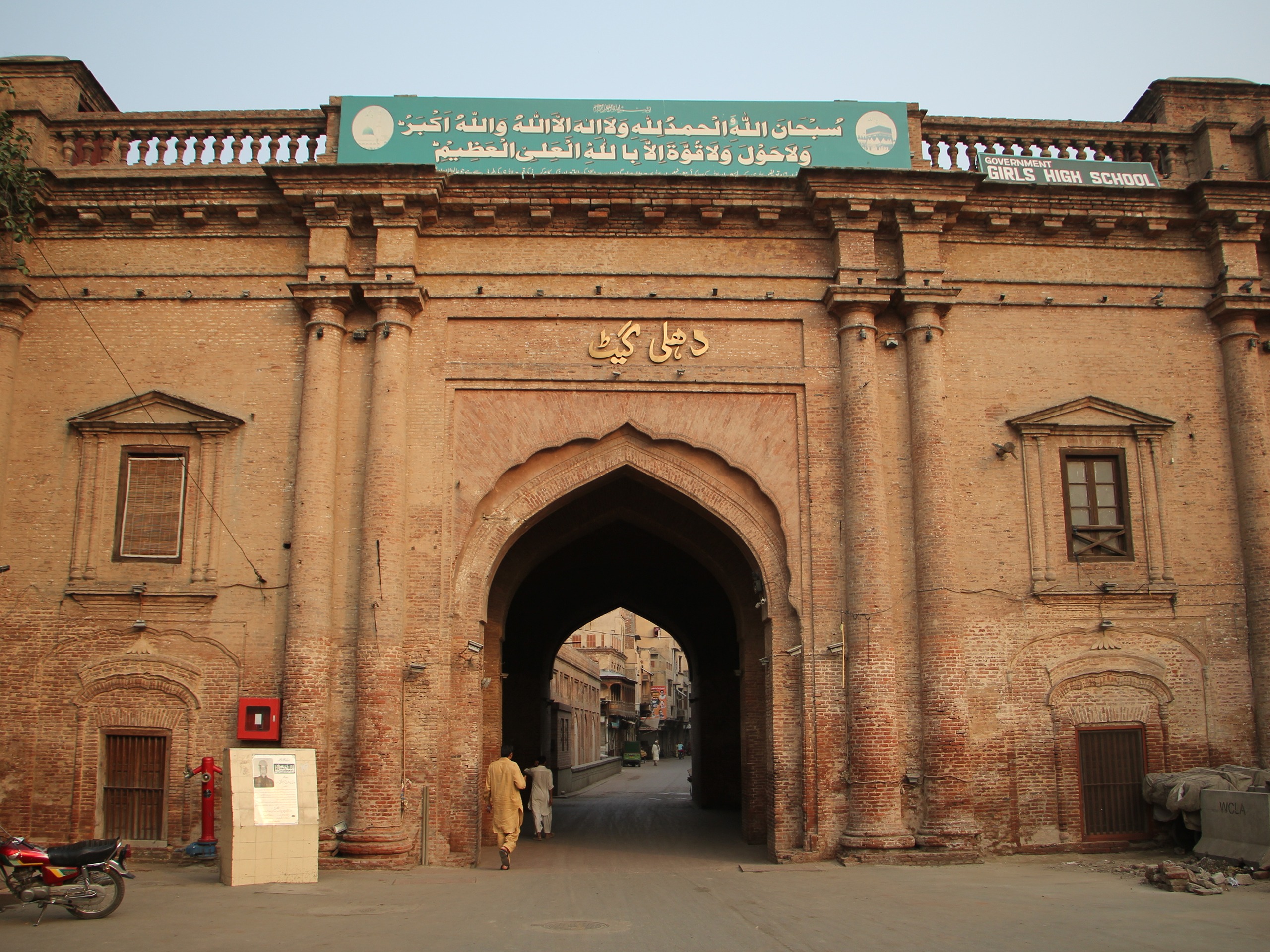
Delhi Gate
Delhi Gate is the main gate of the walled city. It is located on eastern side of the city which was once the main route between the Lahore fort and Delhi. It lies between the Yakki Gate to the north and Akbari Gate to the south, at the western extremity of the Landa Bazaar, beyond Milad Chowk. It is the largest of the gates and one of the most famous and most used. The famous Wazir Khan Mosque is located about 200 meters inside Delhi gate bazaar. Adjacent to the building on its west is the Mosque’s Hammam, the only public bath remaining from the Mughal period. The gate built by Emperor Akbar was still intact when the British took over Lahore from the Sikhs but was in deplorable conditions. The building consists of wings on either side of the main portal made with thick load-bearing walls and vaulted roofs. Some of the rooms have features such as timber beams and joisted roofs. The building is three storeys heighted with the main rooms located on the first floor and raised from ground level by an earth-filled platform. The gate portal has a central deorhi with three sections of varying width and length. The deorhi has a shallow, elliptical domed roof with a recessed medallion at the apex. The front portal has two layered arches. An outer multi foil arch formed by a thin leaf of arched masonry work and an inner, lower four centered structural arch of a simpler Mughal period style supporting the masonry above. The width and height of this arch is about the same as that of the Lohari Gate.
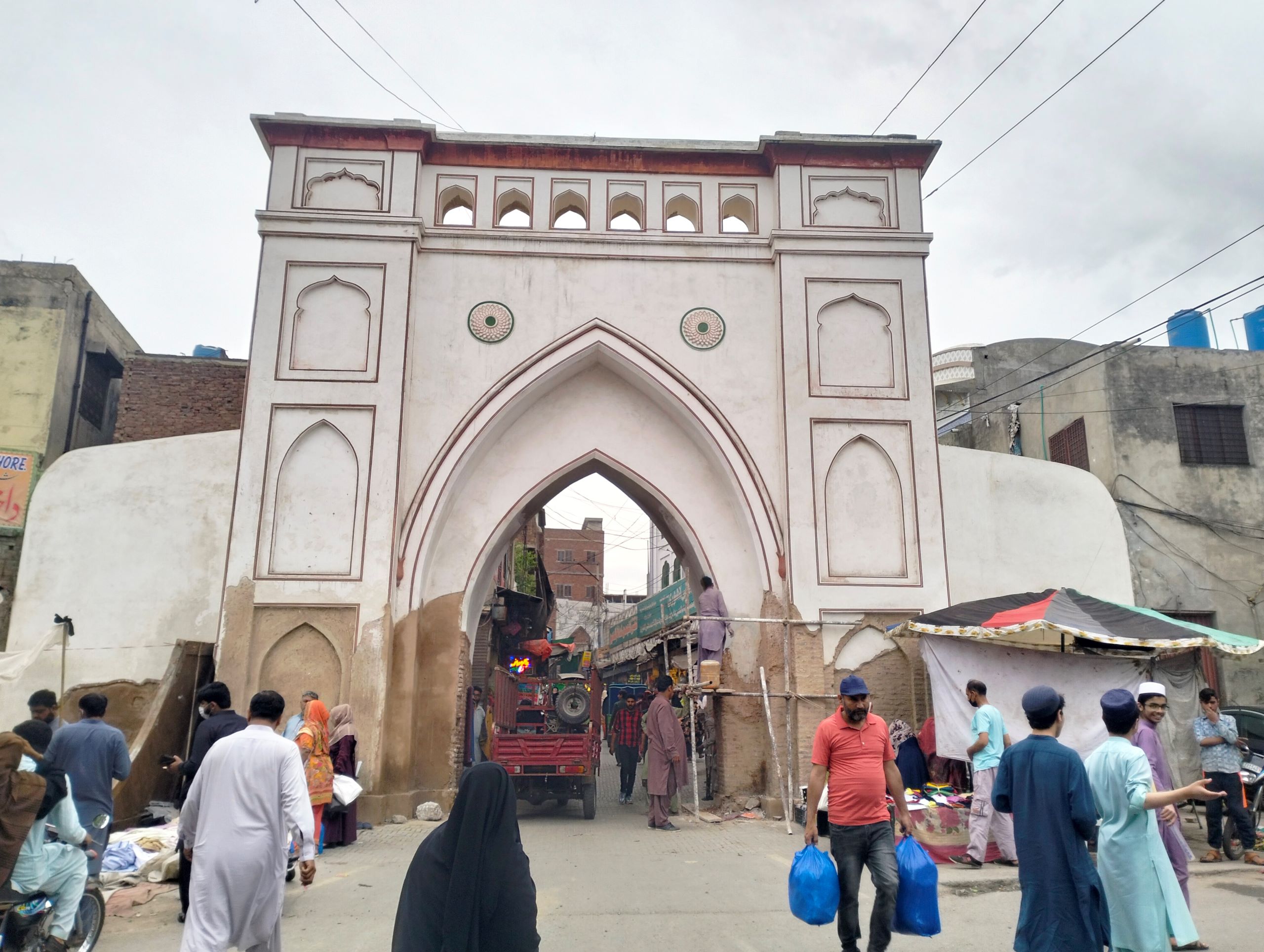
Sheranwala Gate
Sheranwala Gate is one of the northern gates of the city with the Kashmiri Gate to the west and the Yakki Gate to the southeast. The gate building faces north with small buildings scattered haphazardly along the approaching road on the portion of the garden between the Circular Road and the gate. The garden is about 4 metres lower than the level of the gate and the rooftops of the structures along the approach road are lower than the road level at several places. The eastern side of the road is an open park and houses have been built on the west side and on the site of the old city wall abutting the gate structure. The gate was formerly known as Khizri Gate but was named so because Ranjit Singh used to keep two lions in cages at either sides of the gate.Two shamsas or medallions decorate the central entrance arch on the front. The gate once had two wooden shutters but they are now gone.
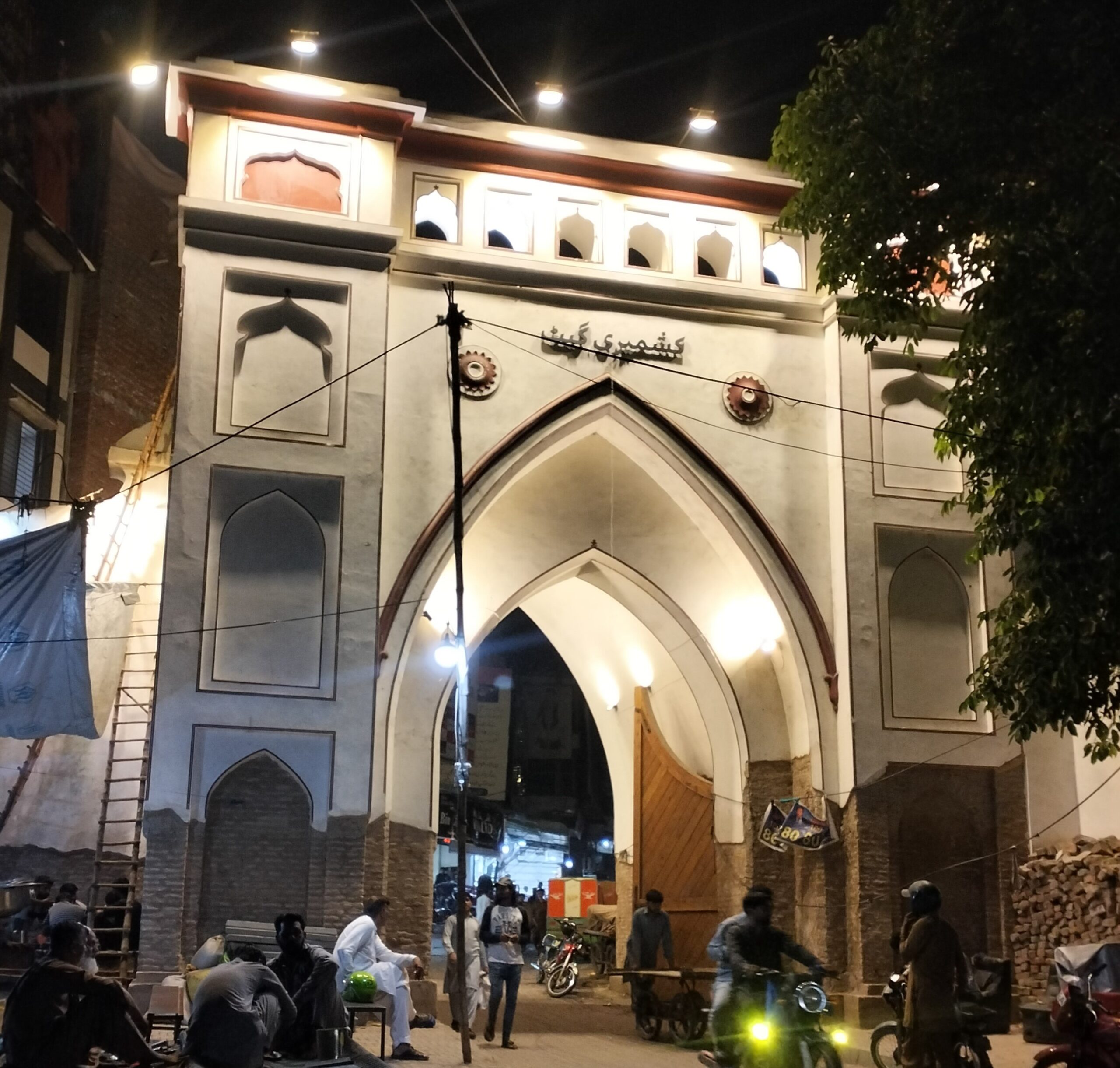
Kashmiri Gate
The Kashmiri Gate is named so because it faces the direction of Kashmir and once opened onto the road that led to Kashmir during Mughal times. The present gate was built by the British in late 19th century in a colonial style and is almost identical to the Sheran wala Gate, also rebuilt by the British. It is small and simple in appearance as compared to the others. Larger gates such as the Lohari and Delhi Gates suggest that the area was probably not regarded as having much significance during that period. Post independence, however, commerce inside the Kashmiri Gate expanded until the area became one of the busiest commercial centers of the Walled city. The gate building is T-Shaped with a symmetrical north-south axis forming the centre of the T. The main portal extends beyond the front and has a gothic type of arch with heavy piers on each side. The Kashmiri gate structure is composed of a deorhi or portico and two interconnected rooms on the east and west. The deorhi is almost square in plan and its floor is part of the road passing through the gate. The gate has minimal decoration. Apart from recessed arches or holes in the front and the rosettes (shamsas) on the sides of the main arch. The building is austere, simply plastered in lime and finished with Pucea Qali.

Akbari Gate
Akbari gate is located on the eastern side of the Walled City. It was named after Emperor Jalal – ud – Din Muhammad Akbar (1542-1605). The gate dilapidated over time and was renovated during the English reign. However, it is currently in shambles once again. The royal leader established a market called Akbari Mandi (Akbar Market) near the gate. It is the biggest wholesale and retail market of Lahore where food grains of all kinds are available for trade. The structure of the Gate does not exist now.

Mochi gate
Located at south of the Walled City of Lahore, ‘Mochi’ gate is a significant mark of the Mughal Empire. Pandit Moti Ram, a guard in the reign of Emperor Akbar, used to watch over the gate and remained associated with his job till his death. Hence, the gate was named after him. However, some historians assert that “Mochi” is a derivative of the Urdu word “ Morchi “ which means “ Trench Soldier “. Further research suggests that different “ Mohallas “ which still bear their old, original names are the “Mohalla Teer-garan” (Arrow Craftsmen) and “Mohalla Kaman-garan” (Bow Craftsmen). Mochi Bagh, a popular location for political rallies in Lahore, is located on the immediate right of the gate. The area inside the gate is known for its dried fruit markets, kite and firework shops. It is also popular for the unbeatable Kebabs, “Das Kulcha with Lonchara” (a mouthwatering breakfast available inside the gate for decades) and Fazal Sweet House, a famous sweet shop of the area. Some reputed Havelis of the Mughal Empire like Mubarak Haveli and Nisar Haveli are also located inside the Mochi Gate area with a number of Imam Bargahs (sacred places of the Shia sect) built within their structures. A big mourning procession starts from Nisar Haveli every year on the 10th of Moharam. The structure of the Gate does not exist now.
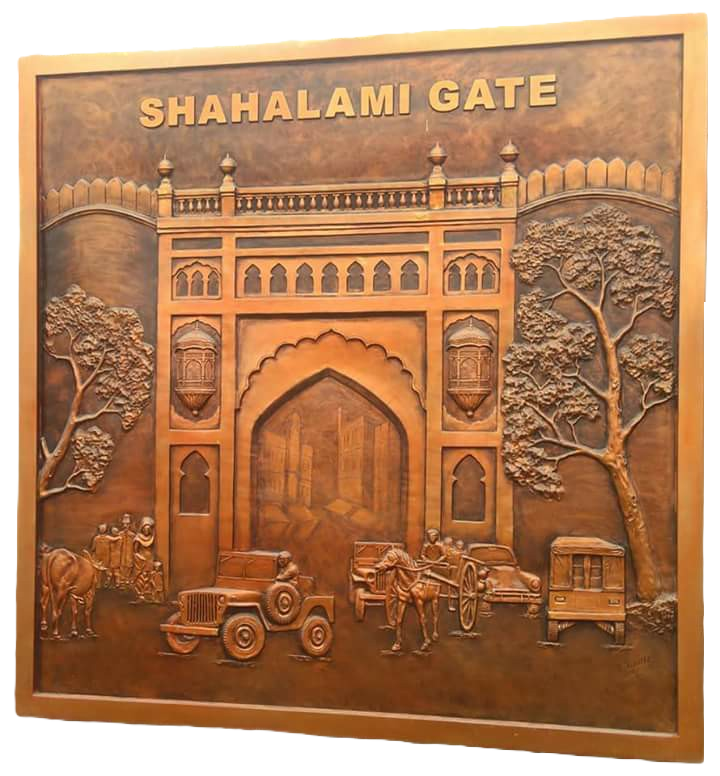
Shah-Alam Gate
Shah Alam Gate or colloquially known as the “Shah-Almi” gate, is the gateway to some of the biggest and busiest wholesale markets of Lahore. From jewelry, garments, crockery, groceries to ceramic vessels, wedding and office accessories to electronic gadgets and toys, you will find almost everything under the globe here. In this regard, “Rang Mahal” is a pertinent bazaar of the gate and remains jam packed throughout the day. Shah Alam gate was named after the son and successor of Auranzaib, Muazzam Shah Alam Bahadur Shah (1707-1712). He was one of the most generous and popular emperors in Punjab. The gate was built on ancient architectural patterns of the other gates of Lahore and was formerly known as the “Bherwala Gate”. During the partition riots of 1947, it was burnt down. The Government of Pakistan issued the Damaged Area Development Ordinance in 1952 and the existing 20 feet wide road was then extended to 80 feet. Now only the name of the gate has remained. Soneri Masjid (Golden Mosque), Mian Khan Haveli and Tomb of Malik Ayaz are the historical sites located inside the gate. The structure of the Gate does not exist now.
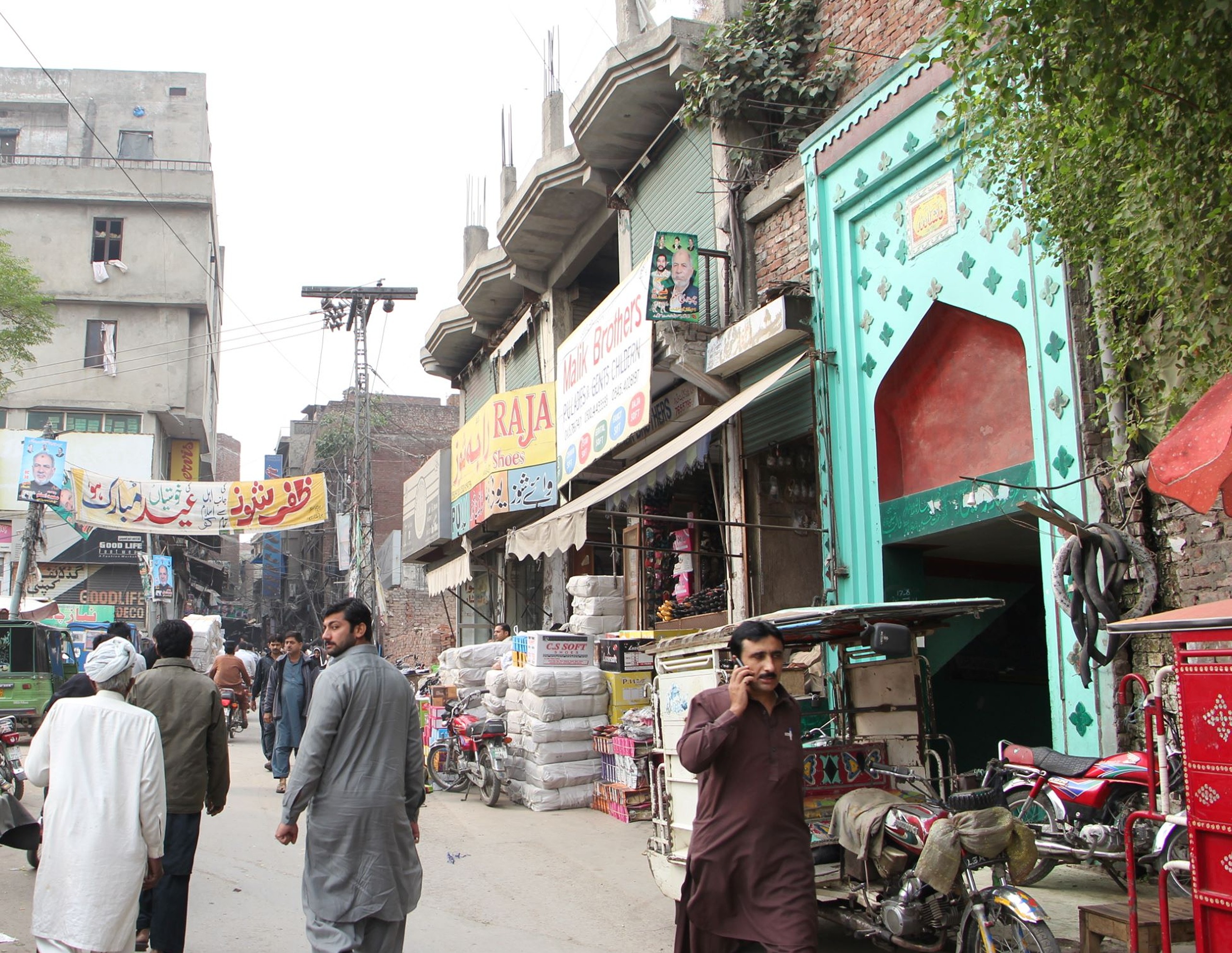
Masti Gate
“Masti Gate” is located on the east behind Lahore Fort. Research asserts that the name of the gate is either derived from the word, “ Masjidi “ (pertaining to Mosque) or named after Masti Balouch, the appointed guard of the gate at the time of its construction. The mosque of Mariam Makhani, the mother of Emperor Akbar, is also located in its immediate surrounding. The Masti Gate area is primarily occupied by shoe vendors and like Lohari and Bhatti Gate, renowned for food. Milk shops of the area are very popular selling a delicious shake made from milk mixed with almonds, pistachios, nuts, kulfi (ice cream) and vermicelli known as “ Rabri walla Dodh “. The structure of the Gate does not exist now. Shah Alam gate was named after the son and successor of Auranzaib, Muazzam Shah Alam Bahadur Shah (1707-1712). He was one of the most generous and popular emperors in Punjab. The gate was built on ancient architectural patterns of the other gates of Lahore and was formerly known as the “Bherwala Gate”. During the partition riots of 1947, it was burnt down. The Government of Pakistan issued the Damaged Area Development Ordinance in 1952 and the existing 20 feet wide road was then extended to 80 feet. Now only the name of the gate has remained. Soneri Masjid (Golden Mosque), Mian Khan Haveli and Tomb of Malik Ayaz are the historical sites located inside the gate. The structure of the Gate does not exist now.
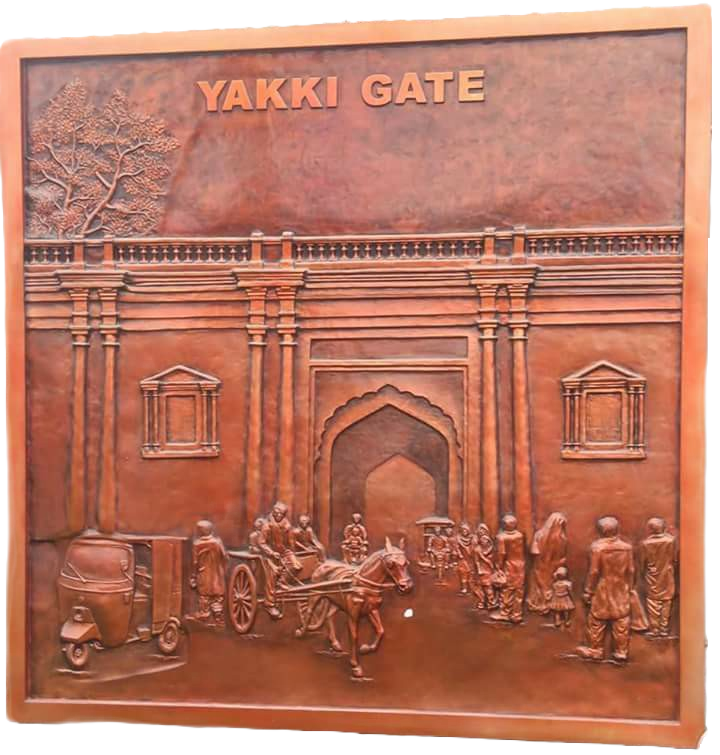
Zakki Gate (Yaki Gate)
Zakki Gate is one of the gates located on the eastern side of the Walled City. It was named after a martyr saint, “Zakki” and has an interesting history. It is said that the great saint was fighting against the “Tataraies” from north and was brutally beheaded. Research suggests that even after being beheaded, his trunk continued fighting for sometime before collapsing. His head and trunk were separately buried at their fallen places and are venerated to this day. There is a school for the blinds situated near the gate as well as a number of Havelis and temples located in and around the Zakki Gate area. The structure of the Gate does not exist now.

Taxali Gate
Taxali Gate is one of the two gates built to enter the Walled City from the West. The gate is named after the Taxal (Royal Mint) that was once existed nearby. Both the Mint and the gate are no longer in existence. Food lovers frequently visit the Texali gate area, as the bazaar surrounding it serves the best Lahori breakfast. Some famous names include Pa’ ay of Fazal Din (Phajjai kai Pa’ay), Halwa Puri of Taj Mahal and Shahbudin Halwai. The bazaar is also famous for the traditional musical instruments that are made and sold here. Another bazaar nearby, the Sheikuprian Bazaar, sells the best quality Khussa, Peshawari and Kohla-Puri Chappal in the city and is visited by people from all over the country. Madhu Lal, a well known sufi saint was born here in 1539. Pani walla talab (an important site of the times) and Gurdwara Lal Khooh (sacred place of worship in Sikhism) are also located near this gate.
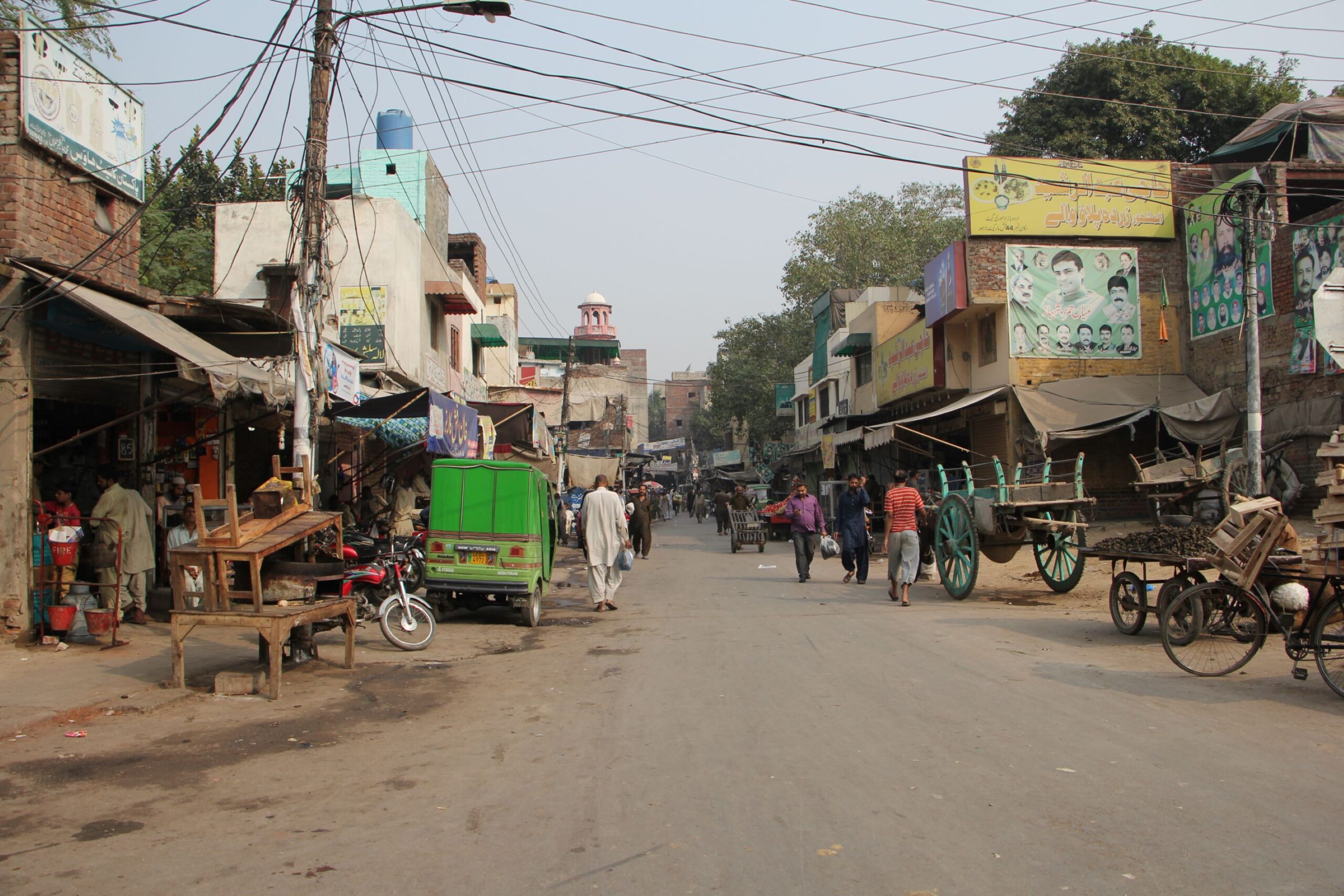
Mori Darwaza
The smallest gate out of all the gates, “Mori Darwaza”, lies between Lahori and Bhatti Gate. It was a gateway instead of a proper gate but is still included amongst the great series constructed during the Mughal Empire. In Urdu, the word “Mori” means a “small hole”. In the evening when all of the twelve gates were closed for security purposes then this particular opening gave access to the walled city and was also used as outlet for the refuse and the sweepings of the city. Inside the gate an alley leads to a square famous as Chowk Jhanda, where the best desi condiment store of olden times, Upal Store, was located. There once existed a narrow street behind the gate leading towards the garden of the haveli of Nau Nihal Singh. Today, though there are no remnants of that garden but the haveli lives to tell the tale along with some of its ornamentation. Just across the gate is Urdu Bazaar famous for its paper, books and stationary. Other famous markets inside the gate include; a huge fish market selling various species of fish and the biggest surgical goods market of Lahore. The natives of the gate are also recognized for the production of a wooden furniture polish commonly known as “Lakh”. Kites and twines are also available inside the gate with people from all over the world specially visiting to celebrate Basant here.
